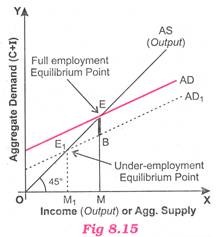This article will help you to learn about the difference between full employment and under-employment equilibrium.
Difference between Full Employment and Under-Employment Equilibrium
(i) Full Employment Equilibrium:
Full employment equilibrium refers to the equilibrium where all resources in the economy are fully utilised (employed).
Simply put, when equilibrium between AD and AS takes place at full employment of resources, it is called full employment equilibrium. There are no unused resources. There is no involuntary unemployment.
Aggregate demand is just sufficient to ensure full utilisation of all available resources. It also indicates that in such a situation aggregate demand is neither in excess nor deficient but equal to supply at ‘full employment level’. It is just equal to what it should be. This is an ideal situation which every economy desires to achieve and ensures its continued existence.
ADVERTISEMENTS:
The situation of full employment equilibrium has been illustrated in Fig. 8.15. X-axis measures the level of output (or AS) whereas Y-axis measures aggregate demand [i.e., consumption demand -I- investment demand). AS is expressed by 45° line whereas the line AD represents aggregate demand
Both the curves intersect at point E which yields full employment equilibrium because aggregate demand EM is equal to full employment level of output OM. (Remember, point E is equidistant from both the axes because E lies on 45° line.) Thus, economy is at full employment equilibrium at output level of OM since all those who are willing to work at the existing wage rate have secured employment.
(ii) Under-Employment Equilibrium:
Under-employment equilibrium means equality between aggregate demand and ‘aggregate supply but at less than full employment’. It is a state of equilibrium where level of demand is less than full employment level of output’. In other words, in producing the output, economy’s all resources are not fully employed, i.e., some resources are underemployed.
ADVERTISEMENTS:
This situation is caused not by low level of aggregate supply but by deficiency of aggregate demand. When level of demand is less than full employment level of output, it is called deficient demand which pushes the economy into under-employment equilibrium. It results in deflationary gap, i.e., gap between aggregate demand and ‘aggregate supply at full employment’.
The situation of under-employment equilibrium has been shown in Fig. 8.15 wherein full employment equilibrium is at point E but under-employment equilibrium occurs at point E1 because AD, (actual) curve intersects the same AS curve at E1 due to inadequacy of demand. OM1 is the under-employment equilibrium level of income which is less than OM full employment equilibrium level of income. Under-employment equilibrium gives rise to deflationary gap shown as EB in the Fig. Since, AD falls short of AS at full employment by EB, therefore, additional investment expenditure equal to the level of EB (i.e., deflationary gap) is required to reach full employment equilibrium.
